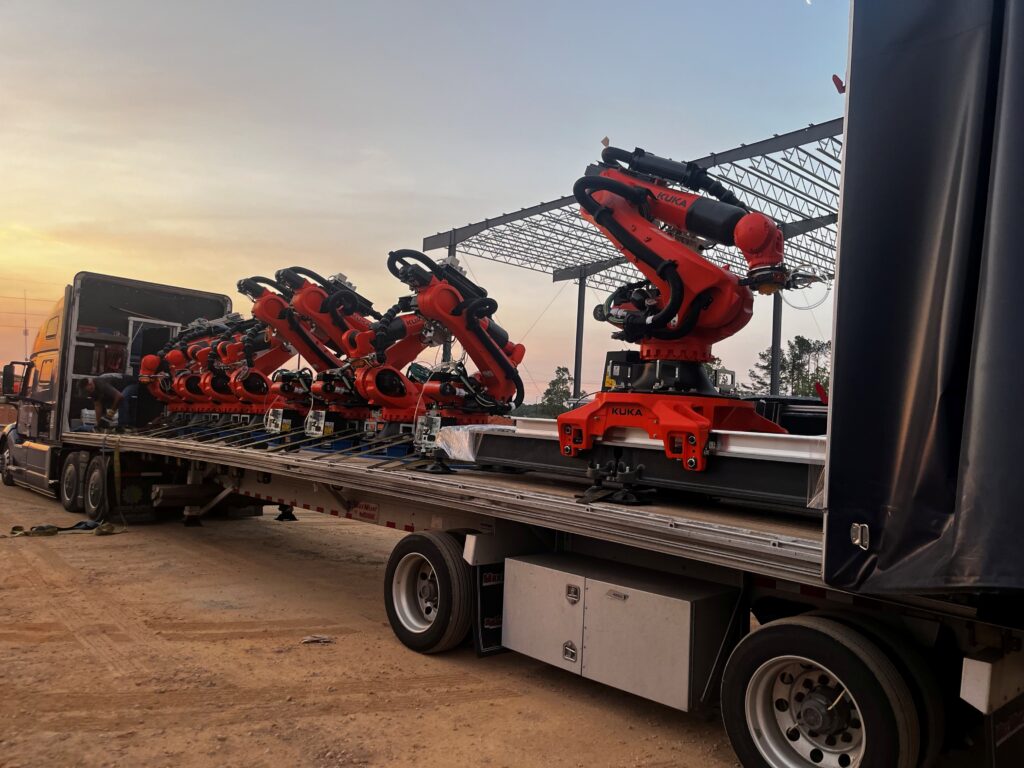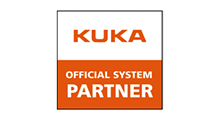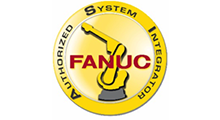Robotics
Robotic Integration for Industrial Automation

Why Choose DRM for Robotic Automation?
Our engineers have brought decades of experience integrating FANUC, KUKA, and other leading robots into high-performance automation systems. From a wide variety of material handling, dispensing and palletizing applications, we deliver solutions that combine precision, speed, and operator-friendly design.
Comprehensive Robotic Engineering Solutions
DRM provides full-service robotic integration, from system design and 3D simulation through programming, installation, and on-site commissioning.
DRM’s robotic systems incorporate advanced features including FANUC’s SoftFloat, iRVision, and Purged Cavity Systems for hazardous locations or KUKA’s Safe Operation, 3rd party vision integration, and optimal performance path software.
Both support a wide range of industrial communication protocols, industry leading safety and simulation systems.
Our expertise includes:
- End-of-Arm Tooling (EOAT) Customization: Tailored tooling designed in-house to support precise gripping, dispensing, and palletizing applications.
- Quick-Change Tooling Systems: Designed for fast changeover with integrated electrical, pneumatic, and Ethernet connectivity.
- Vision-Guided Robotics: Uses advanced machine vision platforms such as Cognex, Banner, and Keyence for part presence verification and precision inspection in real time.
- 7th Axis and Extended Motion Systems: Servo-driven linear rails and track systems increase reach and flexibility for larger or multi-station cells.
- Data-Integrated Robotics: Ensures reliable communication with PLCs, HMIs, and analytics platforms, including AI-assisted performance tools.
- Simulation & Virtual Commissioning: 3D simulation tools are used to validate motion paths, cell layout, and control logic prior to deployment.
Trusted Integrator for FANUC, KUKA, and More
DRM designs and integrates robotic systems built to solve real-world automation challenges. With deep experience across platforms such as FANUC and KUKA, we deliver solutions that improve productivity, reduce manual intervention, and align with each client’s specific process requirements.
KUKA Robotics: A Platinum System Partner
As a KUKA Platinum System Partner, DRM integrates versatile, high-performance robotic platforms suited for a range of applications. KUKA systems are known for their flexible motion control, broad payload options, and compatibility with a wide variety of automation environments, making them well-suited for precision dispensing, palletizing, and material handling.
Why KUKA?
- Advanced Motion Control: Suitable for complex, high-precision dispensing and material handling paths
- Flexible Payload Ranges: Available options support both lightweight assembly and heavy industrial lifting
- Software Integration: Compatible with AI-assisted optimization and Industry 4.0 platforms
- Simplified Recovery: Easy to return to operation after safety interruptions or cell resets
- “The Engineer’s Robot:” Valued for its flexibility, user control, and application-specific tuning
- New Age Teach Pendant: Dual methods for robot jogging. Typical motion keys, but also World Mouse it gives “gamers” super control of robot motion.
- Electronic Axis Mastering: With additional purchased mastering kit, you have absolute axis mastering. This means “no touching up program points” after remastering.
- WorkVisual Programming Software: With this software, engineers can develop offline programming then deploy the WV project to the controller. With the built in syntax checker, errors are caught as code is generated.
FANUC Robotics: Authorized System Integrator (ASI)
DRM has extensive experience integrating FANUC robotic platforms, which are widely used for their speed, durability, and reliability in industrial environments. FANUC systems are especially well-suited for high-throughput applications in automotive, food production, and packaging.
Why FANUC?
- High-Speed Processing: Designed for fast cycle times and automated assembly lines
- Versatile Application Range: Commonly used in painting, welding, pick-and-place, and palletizing
- Add-On Software Options: Extends robot capabilities in custom or non-standard environments
- Global Deployment: More than 750,000 FANUC robots installed worldwide
- Purged Cavity Designs: Enables safe automation in environments with combustible gases or particulates
- FANUC Roboguide Software: This purchased software allows engineers and programmers to not only program with a virtual teach pendant but also import mechanical cell design into project.

Commitment to Industry Standards
DRM prioritizes safety, long-term system reliability, and adherence to industrial best practices. Our robotic systems are designed and implemented in compliance with ANSI and ISO standards to meet the latest safety and performance benchmarks.
Industry Robotics Applications
Our robotic systems are in use across a range of industries, where they support high-performance automation such as:
Automotive Manufacturing
Robotic dispensing applicaions and high-speed part handling
Example: A Tier 2 automotive supplier tasked DRM with eliminating a manual adhesive spray process. DRM engineered a FANUC P-50 painting robot cell with a turntable system that allowed operators to safely load/unload dash assemblies. The Ethernet-connected PLC and HMI managed the cell, and the portable platform ensured easy installation.
Glass Manufacturing
Precision sealing and primer application using KUKA robots
Related Links: Modern Data Solutions for Glass Manufacturing, Vision Systems, Process and Machine Integration
Food Processing
Robotic palletizing, sorting, and line optimization
Example: A national food producer needed a system to stack cases from an assembly line onto pallets. DRM deployed a FANUC R-1000 with a vacuum and fold-out pneumatic gripper. A barcode scanner rerouted failed cases to an inspection lane, and the robot managed pallet exchange automatically — all designed to exceed safety standards.
General Manufacturing
Weld handling, assembly, and coordinated material movement
Related Links: Manufacturing Upgrades, Panel Fabrication, Process Piping, General Contracting
Automated Palletizing: See DRM’s Robotics in Action
DRM’s robotic palletizing systems combine advanced case gripping, real-time quality verification, and coordinated conveyor control. This example, designed for a tobacco production facility, demonstrates how robotic automation improves packaging speed, consistency, and operator safety in regulated environments.
Related Links:
Frequently Asked Questions About Robotics Integration
Q: How do I choose between FANUC and KUKA robots for my automation needs?
A: If your facility already uses a specific robotics platform, we typically continue with that brand for consistency. In some cases, we may recommend a different platform based on availability, system performance, or specialized features. Our partnerships give us access to technical support, compatible accessories, and expedited delivery across multiple robotic brands.
Q: How does robotic integration improve efficiency in manufacturing?
A: Robotic systems improve manufacturing efficiency by reducing repetitive manual labor, increasing precision, and enabling real-time quality monitoring. When combined with vision systems and AI-driven analytics, they can minimize downtime and improve throughput across production lines.
Q: Can DRM help retrofit my existing production line with robotics?
A: Absolutely. DRM specializes in upgrading legacy systems by integrating robotic platforms into existing production lines. We ensure compatibility with your current equipment while improving performance and reliability. We also help identify opportunities to automate highly manual processes that may not have been previously considered.




